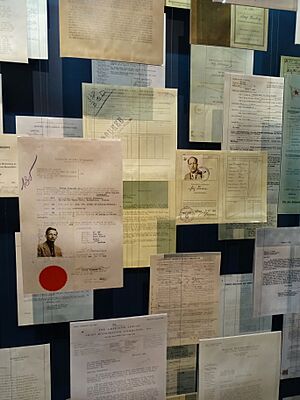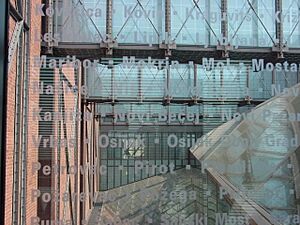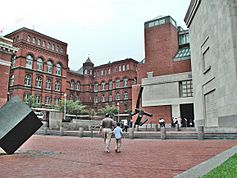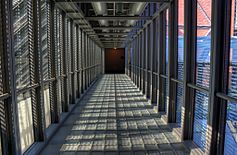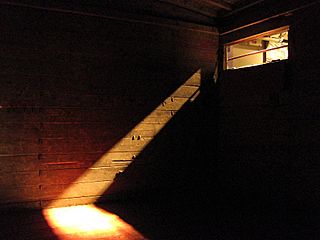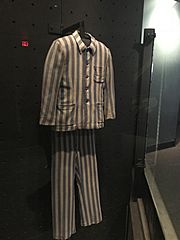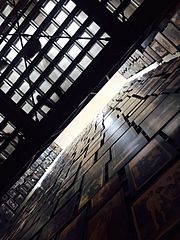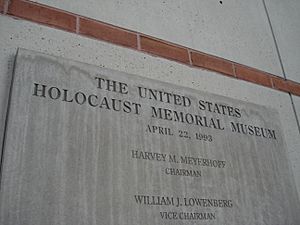United States Holocaust Memorial Museum facts for kids
 |
|
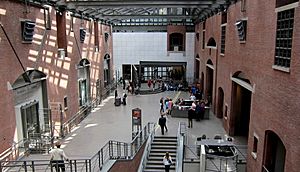 |
|
| Lua error in Module:Location_map at line 420: attempt to index field 'wikibase' (a nil value). | |
| Established | April 22, 1993 |
|---|---|
| Location | 100 Raoul Wallenberg Place, Southwest, Washington, D.C. |
| Type | Holocaust museum |
| Visitors | 1.6 million (2016) |
| Public transit access | |
The United States Holocaust Memorial Museum (USHMM) is America's official museum dedicated to the Holocaust. The Holocaust was a time during World War II when Nazi Germany murdered six million Jewish people and millions of others.
Opened in 1993 in Washington, D.C., the museum teaches visitors about this history. It uses powerful exhibits, educational programs, and stories from survivors. The museum's goal is to help people understand the dangers of hatred and to encourage them to stand up for human dignity and prevent genocide.
Contents
Visiting the Museum
The museum is a very popular and important place. Since it opened, nearly 40 million people have visited, including more than 10 million students. Leaders from over 130 countries have also come to learn from its exhibits.
The museum's website is also a major resource. It gets millions of visits each year from people all over the world who want to learn about the Holocaust.
What's Inside the Museum?
The museum holds a huge collection of items that tell the story of the Holocaust. These include:
- More than 12,750 artifacts, like personal belongings and tools.
- 49 million pages of documents, such as letters and official papers.
- 85,000 historical photographs.
- 9,000 recorded interviews with survivors who share their personal stories.
Researchers at the museum have also documented over 42,500 ghettos and camps that the Nazis created across Europe.
History of the Museum
The idea for the museum began in 1978. President Jimmy Carter created a special group led by Elie Wiesel, a writer and Holocaust survivor. The group's job was to figure out the best way for America to remember the victims of the Holocaust.
They recommended building a national museum in Washington, D.C. In 1980, the United States Congress agreed and provided land near the Washington Monument. The money to build the museum, almost $190 million, was raised from private donations.
In 1988, President Ronald Reagan helped lay the first stone of the building. The museum officially opened on April 22, 1993. At the opening ceremony, President Bill Clinton, Israeli President Chaim Herzog, and Elie Wiesel gave speeches. The museum opened to everyone a few days later, and its first official visitor was the 14th Dalai Lama of Tibet.
Difficult Events at the Museum
The museum has been a target of hatred. In 2002, a plan to attack the museum and other sites was stopped by law enforcement.
In 2009, a man who held hateful beliefs entered the museum and began shooting. A brave security officer, Special Police Officer Stephen Tyrone Johns, was killed while protecting visitors. Officer Johns is now honored with a permanent memorial inside the museum for his heroism.
Main Exhibits
The museum has several powerful exhibits that teach visitors about the Holocaust in different ways.
Hall of Remembrance
This quiet, six-sided room is the museum's official memorial to the millions who were murdered. Visitors can light a candle and see an eternal flame that burns in their memory. It is a peaceful space to think about what happened and honor the victims.
Permanent Exhibition
This is the museum's main exhibit. It tells the complete story of the Holocaust from the 1930s to the end of World War II in 1945.
When you enter, you receive an ID card with the story of a real person who lived during the Holocaust. As you walk through the three floors of the exhibit, you follow their story.
The exhibit uses over 900 real artifacts, 70 video screens, and historic film footage. It covers the rise of Adolf Hitler and the Nazi party, the creation of ghettos, and the "Final Solution," which was the Nazi plan to murder all of Europe's Jews. The exhibit ends with the story of how the Allied armies freed the prisoners of the concentration camps.
Because the exhibit shows difficult images and topics, it is recommended for visitors who are 11 years or older.
Remember the Children: Daniel's Story
This exhibit is specially designed for younger visitors and their families. It tells the story of the Holocaust through the eyes of a young boy named Daniel. The exhibit follows his life in Nazi Germany, helping children understand this history in a way that is easier to grasp. It is based on the true stories of children who lived during that time.
The Museum's Building
The museum's building was designed by architect James Ingo Freed. Freed himself was a Jewish refugee who escaped Nazi Germany as a child. He wanted the building to be a "resonator of memory."
From the outside, the building fits in with the other museums in Washington, D.C. But inside, the design is meant to make you feel the history of the Holocaust. The spaces can feel tight or unsettling, which helps visitors understand the fear and uncertainty that people experienced. The building itself is part of the story.
Learning and Research
The museum is a world leader in Holocaust education and research.
Center for Advanced Holocaust Studies
In 1998, the museum opened the Center for Advanced Holocaust Studies. This is a place where scholars and researchers from around the world come to study the Holocaust. They use the museum's vast collection of documents and artifacts to write books and articles, making sure that this history is never forgotten.
Committee on Conscience
The museum is also home to the Committee on Conscience. This group studies areas around the world where genocide or other terrible crimes against humanity might be happening today. Their goal is to warn leaders and the public about these dangers, in the hope of preventing future tragedies.
Encyclopedia of Camps and Ghettos
The museum is creating a huge encyclopedia that documents every single concentration camp and ghetto run by the Nazis. This massive project, called the Encyclopedia of Camps and Ghettos, 1933–1945, gathers information from archives all over the world. It ensures there is a detailed record of these places for future generations.
Museum Gallery
Outreach and Education
The museum works to share its lessons with people everywhere.
- Online Holocaust Encyclopedia: The museum's website has a free online encyclopedia available in many languages, including English, Spanish, Arabic, and Mandarin. It allows people worldwide to learn about the Holocaust.
- Teacher Programs: The museum trains teachers from across the country. These teachers learn how to teach this difficult history in their own classrooms.
- Training for Professionals: The museum also provides lessons on ethics for law enforcement officers, soldiers, and judges, using the history of the Holocaust to teach about professional responsibility.
Elie Wiesel Award
The museum gives an award to important people who have worked to protect human dignity and prevent genocide. It is named after Elie Wiesel, the museum's founding chairman. Past winners include:
- 2011: Elie Wiesel
- 2013: Władysław Bartoszewski and Veterans of World War II
- 2014: Lieutenant-General Roméo Dallaire
- 2016: US Representative John Lewis
- 2017: German Chancellor Angela Merkel
- 2018: All Holocaust survivors
- 2021: Ambassador Stuart Eizenstat
- 2022: The Ritchie Boys
See also
 In Spanish: Museo Conmemorativo del Holocausto de los Estados Unidos para niños
In Spanish: Museo Conmemorativo del Holocausto de los Estados Unidos para niños
- Auschwitz-Birkenau State Museum
- Austrian Holocaust Memorial Service
- Culture of Remembrance
- Ghetto Fighters' House
- Holocaust Memorial Center
- Illinois Holocaust Museum and Education Center
- List of Holocaust memorials and museums
- List of museums in Washington, D.C.
- Memorial to the Murdered Jews of Europe
- Montreal Holocaust Memorial Centre
- POLIN Museum of the History of Polish Jews
- Stephen Roth Institute
- Task Force for International Cooperation on Holocaust Education, Remembrance, and Research
- The Holocaust and the United Nations Outreach Programme
- Raoul Wallenberg
- Simon Wiesenthal Center
- Yad Vashem
- Yom HaShoah


